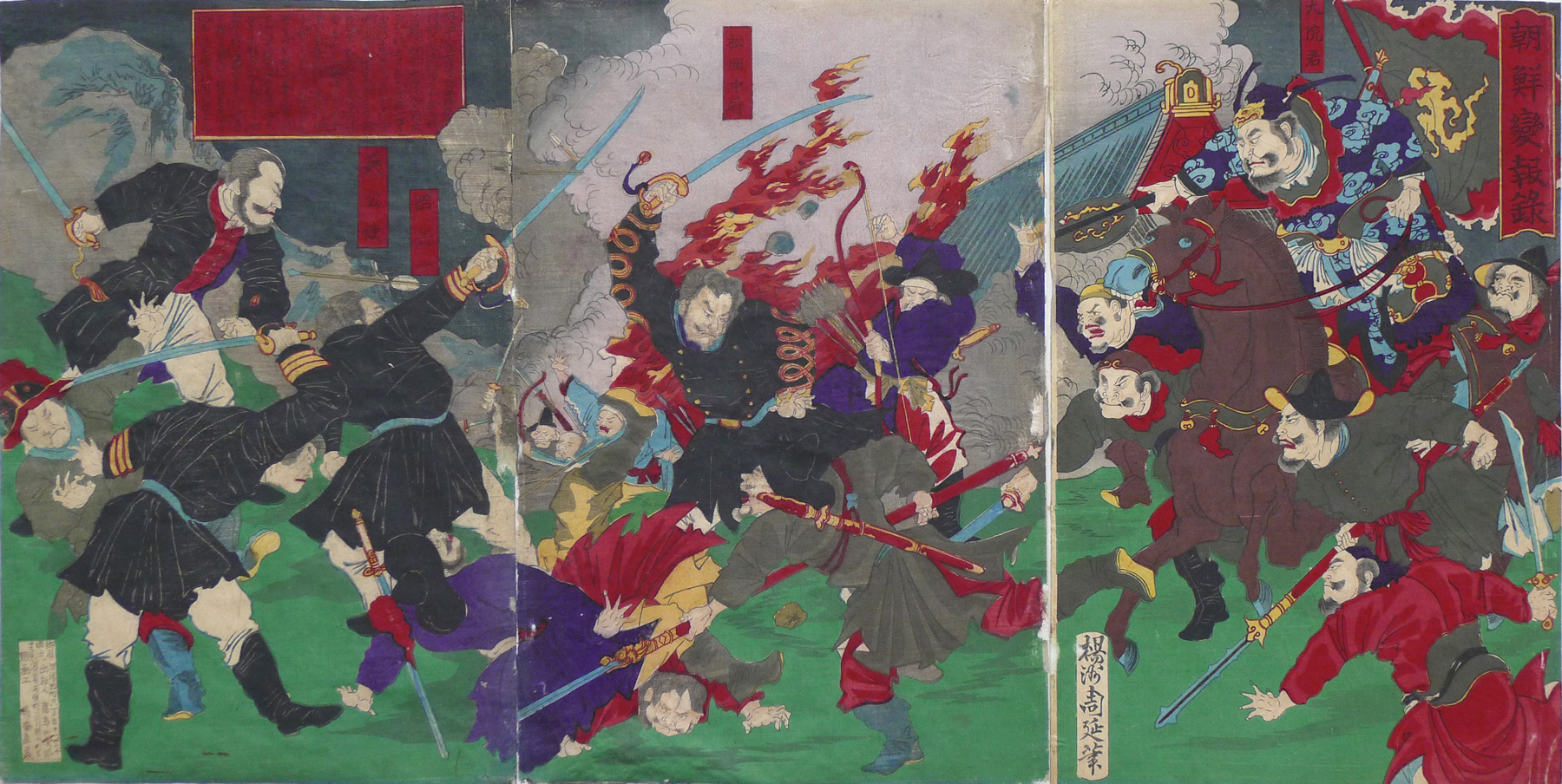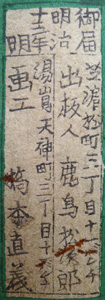About This Print
This print depicts the attack on the Japanese legation in Seoul, Korea on July 23, 1882 by disaffected Korean soldiers. The right panel pictures the former regent of Korea and the father of the Korean king, the Daewongun (大院君), on horseback, leading the mutineers. The legation is shown burning in the background, while the Japanese ambassador, Hanabusa Yoshitada (identified as 英公使, "Minister Hanabusa," in the center panel) and other legation officers fight them off. As with many battle scenes depicted in Japanese prints of the Meiji era, Chikanobu constructs this image from his imagination and news reports, and his depiction of the Daewongun actually leading the mutineers in battle is fictitious.11 although the Daewongun was later to exhort the rioters to "expel the foreigners," no reports or accounts have him actually physically engaging in any of the riots. See details below under "The Korea Incident."
Scroll Detail
click on image to enlarge
The Korea Incident (The "Imo Incident")
Source: Korea and the Politics of Imperialism, 1876-1910, Chong Ik Eugène Kim and Han-Kyo Kim, University of California Press and Cambridge University Press, 1968, p. 33-41.Overview
The "Soliders' Mutiny of the Year of Im-o" (or simply the "Imo Incident") began in early July 1882, a few months after Korea's Min government concluded its second unequal treaty, this time with the United States. (The first being in 1876 with Japan.)
The Imo Incident began in Seoul when a small number of poorly provisioned and ill-treated troops attacked a Min government official in charge of rice rations. Within a few weeks this attack had grown into a full scale mutiny against the Min government and the presence of the Japanese, who had been granted extraterritoriality in their 1876 unequal treaty with Korea.
The July 23 Attack on the Japanese Legation
On July 23, 1882 a group of soldiers mutinied in Seoul, attacking high-ranking Min officials, the Japanese legation and the Japanese military trainers of an elite Korean corps called the Special Skill Force. The head of the Japanese legation, Minister Hanabusa, "was forced to lead 28 Japanese, including about a dozen armed police guards, out of the riot-torn capital" and march through the night to Inch'on (Chemulpo) to seek safety. While initially given a "hospitable reception by the prefect of Inch'on," the Japanese were later attacked by soldiers of the Inch'on garrison, leading Hanabusa to believe that the mutiny was really "a political coup aimed at overthrowing the Min regime, which implied a possible return to the policy of national seclusion."
Fleeing Inch'on, "the Japanese refugees seized a small Korean junk and set out to sea" later to be rescued by the British ship the "Flying Fish" who took them to Nagasaki.
Meanwhile , the mutiny had grown into a "political revolution" with the Daewon'gun exhorting the rioters "to bring down the Min regime and expel the Japanese." The mob went on to attack the royal palace, bringing "a reign of terror" upon the entire city and allowing the semi-retired Daewon'gun to assume power from the queen (who ruled with the king but exercised the real power) whose supporters favored foreign engagement.
The Japanese response to the ligation attack was to demand "an official apology, indemnities, punishment of the anti-Japanese assailants, and the right to station Japanese troops in Seoul as legation guards." "On August 12, Hanabusa landed at Inch'on and, despite protests from the Daewon'gun government, led the Japanese troops into Seoul..." The presence of Japanese troops brought about a similar response from the Chinese government, traditional suzerains of Korea, who dispatched troops to Korea "to restore peace."
The Chinese went on to arrest the Daewon'gun, charging him "with disrespect to the emperor of China in usurping power, which the emperor had invested in the king of Korea." Sparing the Daewon'gun's life, as he was the father of the king, the Chinese removed him from the country and kept him in isolation. Power was restored to the queen and king and the status quo restored.
With the removal of the Daewon'gun the demands of the Japanese were met including the presence of 200 Japanese soldiers as legation guards. A much larger Chinese force also remained in Korea to "keep the Japanese influence in check" and to assert China's suzerain status over Korea. The Special Skill Force was disbanded at Korea's request and the Chinese sent officers to reorganize and train Korean troops.
The above events "demonstrated, above all, the hopeless state of affairs in Korea and its inability as a nation to sail under its own steam in the troubled and strange waters of international politics."
Print Details
| IHL Catalog | #865 |
| Title or Description | Record and Transcript of the Korea Incident 朝鮮変報録 |
| Series | |
| Artist | Yōshū Chikanobu (1838-1912) |
| Signature |  |
| Seal | no seal |
| Publication Date | 1882 (明15) |
| Publisher | Kashima Matsujirō 鹿島松次郎 [Marks: 26-052; publisher ref. 211] |
| Impression | excellent |
| Colors | excellent |
| Condition | fair – left and right panels pasted together, album backing removed, paper damage and loss repaired from back; soiling, primarily visible on faces of figures |
| Genre | ukiyo-e; senso-e; |
| Miscellaneous | |
| Format | vertical oban triptych |
| H x W Paper | 13 7/8 x 28 in. (35.2 x 71.1 cm) overall size |
| Literature | |
| Collections This Print | Tokyo Keizai University Library N0.48 |
4/19/2020




